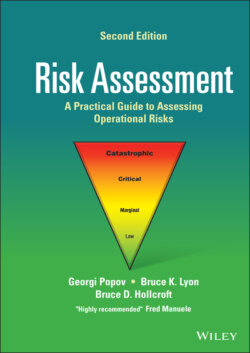Читать книгу Risk Assessment - Georgi Popov - Страница 60
3.9 Risk Identification
ОглавлениеFor operational risks, hazards are the source of risk. Thus, if risks are to be assessed, hazards must first be identified and described. Risk identification is defined as the process of finding, recognizing, and recording risks. Its purpose is to identify what might happen and/or the situations that could impact the system or organization. Risk identification should include the identification and description of the source of the risk (hazard in the context of physical harm) and its causes; events, situations, or circumstances which could have a material impact upon objectives; the nature of impact; and any existing controls for the identified risk (ANSI/ASSP/ISO 31010, 2019).
Methods for identifying existing and potential risks in the workplace are many. A likely starting point might begin with collecting available information about the operations to be assessed. Some hazards (risk sources) are easily identified intuitively or through recent or past experience, while others require more systematic methods of identification. Depending on the operation or subject of the assessment, the level of effort will vary accordingly. A simple job or task may only require a job hazard analysis, while a more complex system may require a series of methods to identify existing and potential hazards.
There are many ways to go about identifying hazards and operations for assessment, but a systematic approach will likely be more thorough and reliable. Some of the more common methods and sources used by safety professionals to identify hazards are listed below.
Brainstorming
Checklists
Regulations (OSHA, EPA, DOT, etc.)
Consensus industry standards (ANSI, ASTM, NFPA, etc.)
Experts (external or internal)
Job Hazard Analyses/Job Safety Analyses
Accident/incident investigations
OSHA Injury and Illness Records
Insurance claims
Formal hazard/risk identification techniques42 listed in ANSI/ASSP/ISO 31010‐2019 and50 methods listed in ANSI/ASSP TR 31010‐2020 Technical Report on Risk Assessment
Each risk identification method has its strengths, limitations, complexity level, resource requirements, and outputs. In some cases, more than one technique may be used to identify the risk‐related information needed. These techniques are used in conjunction with the established risk criteria and context that is discussed in the next chapter.
